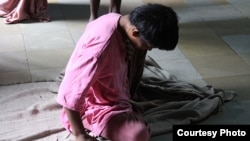Sunday, March 8th, is International Women’s Day. This year’s theme -- Making it Happen -- recognizes the contributions women make to society. But a rights group is also using the occasion to call attention to women and girls with disabilities. It said they are at greater risk of sexual violence.
Human Rights Watch said all governments should ensure that women and girls with disabilities are included in programs to prevent gender-based violence. The group has released – what it calls – a resource designed for people with disabilities.
HRW’s Disability Rights Director Shanta Rau Barriga said this information must get to the people who need it most.
People with disabilities, especially women, are disproportionately vulnerable to violence. They’re actually three to four times more likely to experience violence in their lifetimes. Yet, what we found in a number of countries is that they are not even getting information on what is violence and what they can do to get help.”
She said, for some, it can be difficult to discern what inappropriate behavior is.
“This document that we’ve released is in what’s called “Easy to Read” format, which is particularly designed for people who have intellectual disabilities or learning delays and have never gotten information on what is appropriate type of behavior. So, for example, you know what’s often called good touch and bad touch. When a family member, friend or even someone in their community asks them to do things that they don’t realize is not really OK and they are allowed to say no, but never really got that lesson,” she said.
Barriga said that women and girls with disabilities often face “multiple barriers accessing sexual and reproductive health care, as well as psychological and criminal justice services.”
“When it comes to women with disabilities, they still are hidden. We have been documenting this issue in a number of countries. And in some cases they have never told their stories of rape and sexual violence to anyone else before they told us. This population is invisible. We should keep in mind there’s a billion people with disabilities in the world and that’s 15 percent of the world’s population,” she said.
The Human Rights Watch official said there are a number of reasons why people with disabilities are not included in gender violence prevention and response programs.
“One, there’s a belief in many countries that people with disabilities are asexual -- that they don’t need this kind of information on sexuality. So, they’re not included. There are also physical and communication barriers. Is the information provided in sign language or in Braille? Or is it provided in schools that are accessible to children? We even have cases of children with disabilities who were told not to go into the HIV prevention class because they don’t need this information,” she said.
She said abuses by family members or primary caregivers against children “may be the hardest to detect.” HRW gave the example of a 16 year old Zambian girl with intellectual disabilities. She had given birth to three children. It’s suspected she was raped by her father.
“People with disabilities are often dependent on their family members or caregivers in so many ways – financial support and just general, everyday living support. So it’s difficult for them to actually come out and speak out against violence committed by these individuals,” Barriga said.
Barriga said governments should consult with people with disabilities and the organizations that advocate for them. She says they can also translate information into more accessible formats. For example, using simple language would make easier for those with intellectual disabilities or those who lack education. She also said the issue should be part of the new Sustainable Development Goals being developed this year.










